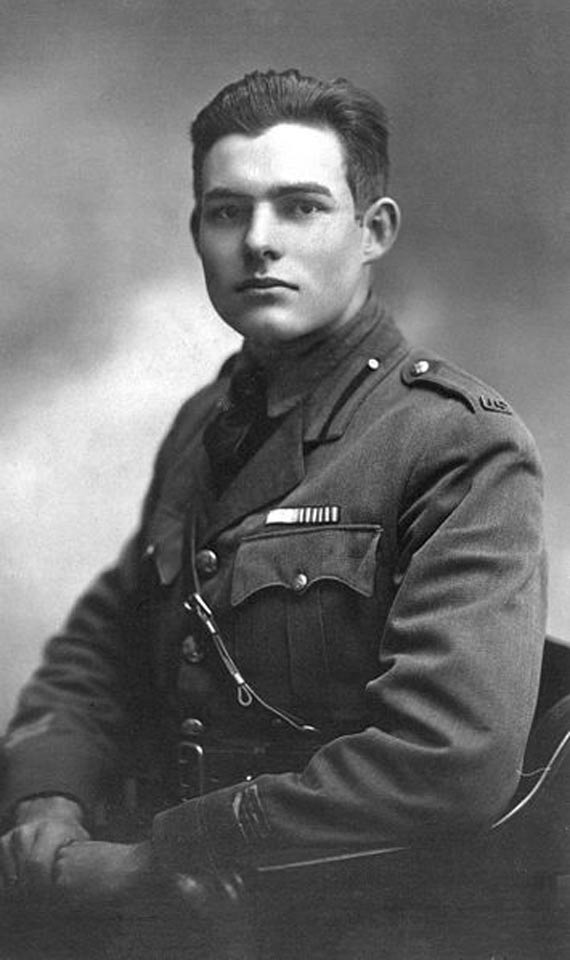Embarking to Europe for a tour of duty as a volunteer Red Cross ambulance driver, Ernest Hemingway traveled on the French Line’s SS Chicago.
Writing to his parents, Hemingway noted its departure date as Thursday, May 23, 1918, and described it as “the rottenest ship in the world.” He was in good company, however. In addition to the American volunteers for the Red Cross, YMCA workers, the Knights of Columbus, and other relief agencies, there was a Polish Army contingent, made up of Poles recruited in the US, trained in Canada, and joining a French sponsored force called the Polish Army in France. This was the last voyage for the SS Chicago as a Polish Army transport. Hemingway wrote to his parents, “We are also paling [sic] with two Polish Lieutenants, Count Galinski and Count Horcinanowitz, altho [sic] [i]t is not spelled that way. And they are dandy, and being with them has taught us that there is a big difference between polacks and Poles.”
The two Poles encountered on the voyage were included in a prologue to Hemingway’s abandoned novel on his World War I experiences entitled, Along with Youth. The pencil manuscript dated June 15, 1927, was reworked and published posthumously in 1972 as “The Night Before Landing,” in The Nick Adams Stories, an anthology of stories and sketches.
Historically, the PMA is interested in learning more about the two counts. Their claims to nobility are not exaggerated. The Chocianowicz family is of the herb (clan) Oksza and the Galinski family is of the herb (clan) Rawicz, however, any claim to title was lost in the United States. Fortunately, their Polish Army in France enlistment records are included in the PMA Archives collections, which feature records for about 85% of the 38,000 Poles in America who enlisted. Ideally, perhaps in a private collection, photographs exist of the counts which could be shared with the PMA.
Antoni Galinski a carpenter from Kansas, was age 47 upon enlisting. Generally older for a Lieutenant, he previously spent three years in service in the Austro-Hungarian Army’s cavalry. He was an early volunteer, enlisting in Center No. 18, Kansas City, KS, on December 21, 1917.
Leon Chocianowicz, a mechanic from Wilmington, DE, was 24, the right age for a junior officer. Though he had no previous military service, he had participated in the Polish Falcon training program. Hemingway described him as being tall; Form C of his enlistment papers confirms this, as it marks his height at 5 foot, 11.5 inches. He enlisted in Center No. 31, Wilmington, DE, on November 17, 1917.
Both were at Camp Kosciuszko in Niagara-on-the-the Lake, Ontario. Upon completion of basic training and then taking an abbreviated Officer Training Course, they became cadre for the next basic trainee classes, shipping out for France after a few training cycles.
The notes to Hemingway’s letter, which is included in The Letters of Ernest Hemingway: Volume 1, 1907-1922 (Cambridge University Press, 2011), unfortunately do not offer additional details. Hemingway may have been aware of the ongoing recruitment in Chicagoland Polish communities, so the mention of Poles and Polish officers would not have been unusual. However, 60 years later, that historical fact has pretty much vanished in America’s consciousness. As the commentators to the notes likely were of a literary and not historical background, the idea of Polish Army men going to Europe from America did not pique their curiosity. It is also interesting to note, that although Poles, Hemingway was able to converse with them in English. This is most likely due to many of them having arrived in the United States as teenagers and were taught in English, or learned the language to function better in the larger community.
In order to better understand the full context of Hemingway’s travel to Europe and to know the Polish counts, the PMA welcomes any details, and especially photographs, of Antoni Galinski and Leon Chocianowicz. Please send all information to PMA@PolishMuseumofAmerica.org, as this will greatly add to this analysis of this literary tale.
Jan Lorys

